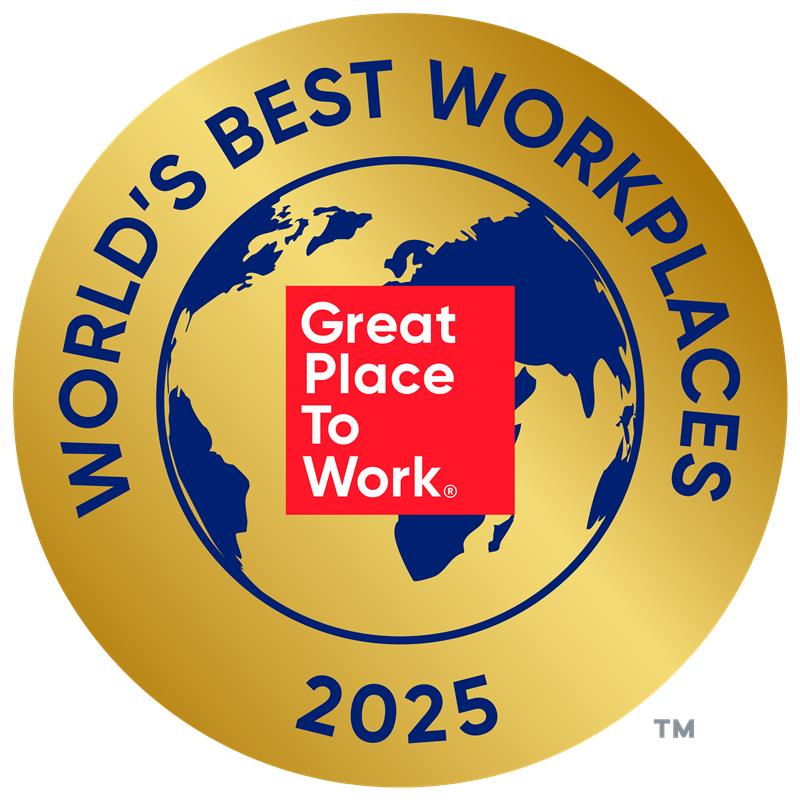
At Experian, we often say our people are our biggest superpower – and today, I’m thrilled to share that this belief has been recognised once again. Experian has been named one of the 2025 World’s Best Workplaces™ by Fortune and Great Place to Work® for the second year in a row.
This achievement reflects the culture we’ve built together – one that’s welcoming, inclusive, and rooted belonging. It’s a celebration of every colleague who brings their whole self to work, who lifts others up, and who powers opportunities for our clients, consumers, and communities.

We’ve made it our mission to create a workplace where everyone feels included, respected, and empowered. That’s why we’re proud to have earned top scores on the Corporate Equality Index and the Disability Equality Index, and to be recognised with the Outie Award for Workplace Excellence and Belonging.
These recognitions matter. But what matters most is how our people experience life at Experian. Whether it’s collaborating, innovating, or growing through world-class development of products, services and contributing to our communities, our culture is designed to help everyone thrive.
We’ve also made bold commitments to career development. Initiatives like Global Careers Week, the AI-driven performance coach Nadia, and the NextGen Forum – a global leadership development programme for emerging talent from across our regions – give our people the resources to take charge of their growth and build a “One Experian” mindset.
Being named one of the World’s Best Workplaces is a moment to celebrate but also a reminder to keep aiming higher. The world of work is evolving fast, and so are we. From embracing AI to enhancing our digital workplace experience, we’ll continue to push forward and listen to our people every step of the way.
Questions we will discuss:
- What does “retirement readiness” mean to you, and how can someone tell when they are financially ready to retire?
- Is there a magic number for retirement savings, and what factors should someone consider when setting a retirement goal?
- How can someone estimate their retirement expenses realistically?
- What are some common myths or misconceptions about how much money you need to retire?
- How should Gen Z, Millennials, and Gen Xers each approach retirement planning differently based on their stage of life?
- What are the biggest obstacles people face when trying to save for retirement, and how can they overcome them?
- How can you balance saving for retirement with paying off debt or supporting family today?
- What tools, calculators, or strategies can help people figure out if they’re on track for retirement?
- How can people prepare for unexpected costs or life changes that could impact their retirement plans?
- What’s one piece of advice you’d give someone just starting—or restarting—their retirement savings journey?
| Columns 1 | Column 2 | Column 3 | Column 4 |
|---|---|---|---|
| Row 1 Col 1 | |||
| Row 2 Col 1 | |||
| Row 3 Col 1 | |||
| Footer 1 | Footer 2 | Footer 3 | Footer 4 |

Credit Chat
Stretching your Dollars: Practical Tips to Cut Costs and Save More
February 5, 2025 3-4 PM ET
- What does “retirement readiness” mean to you, and how can someone tell when they are financially ready to retire?
- Is there a magic number for retirement savings, and what factors should someone consider when setting a retirement goal?
- How can someone estimate their retirement expenses realistically?

Greater transparency in buy now, pay later activity is key to helping consumers build their credit histories and supporting responsible lending. We have members of the military right now right out of high school and there’s not a lot of experience managing their own money. They’re quickly thrust into a place where they don’t have a support system to do that. We have members of the military right now right out of high school and there’s not a lot of experience managing their own money. They’re quickly thrust into a place where they don’t have a support system to do that. We have members of the military right now right out of high school and there’s not a lot of experience managing their own money. They’re quickly thrust into a place where they don’t have a support system to do that. We have members of the military right now right out of high school and there’s not a lot of experience managing their own money. They’re quickly thrust into a place where they don’t have a support system to do that. We have members of the military right now right out of high school and there’s not a lot of experience managing their own money. They’re quickly thrust into a place where they don’t have a support system to do that.
Experian North AmericaScott Brown, Group President, Financial Services

Half of married couples in the U.S. say that credit scores were important to them when choosing a mate, according to the latest Experian Consumer Services survey comparing the relationship between marriage and credit. The study also showed that 95% of participants rate “financial responsibility” as important, with “physical attractiveness” and “career ambition” following at 86% and 77%, respectively. Even more surprising, married adults ranked financial compatibility high, even slightly higher than sex and intimacy. In fact, 73% of women and 60% of men stated that having a partner who is willing to communicate openly about personal finances and credit makes him/her more attractive. Check out what else married couples said about their relationship and finances in the complete summary of our survey results here: Love and Marriage… and Credit from Experian_US

According to new research from Experian Marketing Services, a global provider of integrated consumer insights, targeting, data quality and cross-channel marketing, mobile devices are playing an increasingly important role in how users make purchases across all categories. While purchases using a computer or digital tablet still reign supreme, transactions via mobile phones are on the rise, and marketers are poised to take advantage of this trend. The adoption of mobile marketing increased 17 percent in 2013, while 71 percent of marketers currently are engaging consumers in the mobile channel. This trend, among others, is highlighted in Experian Marketing Services’ recently released 2014 Digital Marketer: Benchmark and Trend Report. The report is an annual go-to resource for marketers looking for key industry benchmarks, insights, technology trends and consumer data. “Using a mobile device as a shopping tool is one thing; using it to make a purchase is another,” said Bill Tancer, general manager of global research, Experian Marketing Services. “One industry in particular that marketers recently have taken advantage of is food. Consumers are increasingly moving from researching on their mobile devices to actually making food purchases on-the-go, including grocery home delivery and even onsite point-of-purchase, where available.” Mobile food purchase trends When it comes to food purchases, affluents are 12 percent more likely to purchase food products through their mobile phone, 29 percent more likely to purchase through their tablet and 30 percent more likely to purchase through their personal computer. Affluent consumers also are more likely to visit the Websites of popular family restaurants, as well as the leading reservations site, OpenTable.com. As of April 2014, the top five food Websites visited by affluents were: Charitable giving Among device owners, purchase rates consistently are higher on tablets and computers than on smartphones due to the larger screen. However, the one exception is charitable giving. Affluents are just as likely to have made a charitable donation from their smartphone as they are to have made one from their tablet, and contributions made from a computer are only marginally higher than those on tablets and phones. Charitable organizations have made donating as easy as sending a text, which is likely why charitable donations is the only category with mobile purchase rates as high as those from a tablet. “Marketers can take a page from the charitable sector’s playbook and streamline their own purchase process. This might include allowing repeat customers to conduct transactions using financial information on file, using mobile-optimized design for collecting payment information or other innovative approaches that allow the would-be customer to transact from anywhere,” added Tancer. Mobile travel purchase trends One category favored by affluent consumers is mobile travel purchases. Affluents are 16 percent more likely than average to book travel from a mobile phone, 42 percent more likely to book from a tablet and 31 percent more likely to book their travel through their personal computer. “The data highlighted in our Digital Marketer Report reveals that a demographic such as affluents, who are prime for booking travel, is only booking travel at marginally higher levels than average via mobile. This means that travel marketers can benefit from focusing efforts on streamlining the mobile booking process,” said Tancer. Overall, the report highlights how marketers can take advantage of this data to more successfully target and engage with their customers. The percentage of mobile phone owners who say they are interested in receiving advertising on their mobile phone has risen by 45 percent since 2010. Nearly one in 10 mobile phone owners today say that they are likely to buy products that they see advertised on their phones, up from 6 percent in 2010. The 2014 Digital Marketer: Benchmark and Trend Report is available via a free download at http://ex.pn/PpijOx.

Experian® is pleased to announce its partnership with Clear Channel and the premiere of its iHeart Radio show, Credit & Finance Talk with Experian, which is already gaining lots of listeners. Credit & Finance Talk with Experian The show covers topics like “Getting Rid of a Bad Score” and “Items on Your Credit Report” to educate listeners on the importance of credit in their everyday lives. Listeners are invited to check back every week for new episodes of Credit 101, where you can get the inside scoop on how to live credit-confident. Premiere Endorsements The next time you listen to a Clear Channel radio station, you might just hear your favorite radio personality chatting about Experian Credit TrackerSM. Our partnership features premiere radio personality endorsements from Ryan Seacrest, Delilah, Jay Mohr, Steve Gorman and John Boy & Billy. Exclusive iHeart Radio Theatre Along with radio, Experian has the incredible opportunity to sponsor entertainment at the iHeart radio theatre and had the opportunity to already share the experience with fans of Coldplay, Young the Giant, and Rascal Flatts. We are excited to partner with Clear Channel to help bring credit education to consumers nationwide. Be sure to check back for more exciting episodes of Credit 101, engaging interviews, credit information and more. You can also find answers to common credit questions here on Experian.com.
2024 Best Place to Work for Disability Inclusion


